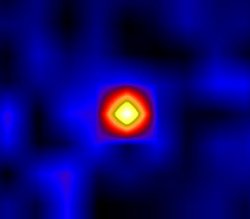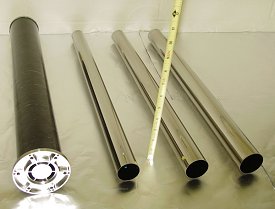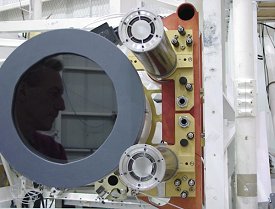|
Scientists at NASA's Marshall Space Flight
Centre have captured the first focused hard x-ray images of the
cosmos.
by Dr Tony Phillips
The real voyage of discovery consists
not in seeking new landscapes, but in having new eyes. --Marcel
Proust
Since 1931, when Karl Jansky accidentally
invented the radio telescope, astronomers have found again and again
that there's more to the Universe than the human eye can see. Radio
telescopes, infrared and ultraviolet detectors, x-ray and gamma-ray
satellites have revealed details of a cosmos teeming with exotic
objects like black holes and pulsars that don't show up through
the eyepiece of an optical telescope. Indeed, every part of the
electromagnetic spectrum has offered one surprise or another to
astronomers.
Now, say astronomers, prepare to be
surprised again. In just May 2001 scientists at NASA's Marshall
Space Flight Centre (MSFC) opened a new wavelength band for high-sensitivity
astronomy: "hard" x-rays.
"What we've done is really just a first
step," says Brian Ramsey, the leader of the MSFC team -- but it's
a big one. Using a revolutionary telescope floating on a balloon 40
km above Earth's surface, Ramsey and his colleagues, including engineers
Jeff Apple, Kurtis Dietz and others, captured focused hard
x-ray images of Cygnus X-1 (a black hole accretion disk) and the Crab
Nebula (the seething remnant of a supernova explosion) and its pulsar.
They are the first such pictures of any heavenly body.

Image credit: MSFC HERO team.
The first-ever
focused hard x-ray image of Cygnus X-1. |
"This is an historic breakthrough,"
said Martin Weisskopf, project scientist for NASA's Chandra X-ray
Observatory. "Collecting the very first focused hard x-ray images
of these sources is an exciting milestone."
Hard x-rays are photons with about
the same energy as medical x-rays (> 10 keV), or ~20,000 times
more energy than visible light. Such x-rays reveal some of the most
violent phenomena in the Universe, including colliding galaxies,
fiery stellar explosions, and hot disks that swirl around black
holes. Astronomers have flown hard x-ray detectors before, but until
now none could focus the radiation to produce crisp images with
high sensitivity.
"Focusing hard x-rays is difficult,
because they are absorbed by conventional lenses and mirrors," explains
Ramsey. "The only way to reflect a hard x-ray photon is to bounce
it from a mirror at grazing incidence -- that is, at a very shallow
angle." It's a little like skipping stones across a stream. The
rock (or x-ray photon, as the case may be) will skip only if it
glances off the surface at a small angle. "The reflection angles
for x-ray mirrors are just a few arcminutes," says Ramsey. "That's
why x-ray mirrors are shaped like long cylinders."
"The really important thing about focusing
x-rays is not just the ability to produce detailed images it's also
about sensitivity," he continued. "Suppose we sent aloft a 1000
square-centimetre detector on a high-altitude balloon and pointed
it toward the Crab Nebula. We might collect 50 hard x-ray photons
per second from the Crab. Meanwhile, the detector would also be
hit each second by, perhaps, a thousand unwanted background photons.
X-rays produced when cosmic rays hit Earth's atmosphere and the
infrastructure of the experiment itself. That's a poor signal to
noise ratio.
"The power of x-ray mirrors is that
they take all the photons from a source like the Crab and focus
them on one tiny spot. Signal to noise shoots way up! In fact, the
better the mirror's angular resolution, the better the signal-to-noise
ratio will be. That's why good mirror performance is so important."

Photo credit: Carl Benson, MSFC
Three "mass
produced" HERO x-ray mirror shells (right) and a nested grouping
of mirrors within one cylindrical tube (left).
|
Grazing incidence x-ray mirrors per
se are nothing new. Ones on board NASA's Chandra observatory
focus soft x-rays and produce images with sub-arcsecond resolution
-- better even than groundbased optical telescopes can do. "Chandra's
doing a superb job on the soft x-ray sky," notes Ramsey, "but the
hard x-ray sky remains mostly unexplored because, until now,
we've never had focusing mirrors that worked well above 10 keV."
Why not?
Ramsey explains: "At hard x-ray energies,
the incidence angle for a good reflection is so small that a single
mirror offers little collecting area. The only way to gather enough
photons to form a good image is to use many mirrors." In years past
that was expensive and difficult.
But no longer. Ramsey and his team
used a replication technique to mass produce affordable high-precision
x-ray mirrors, which they can nest one inside another to increase
the collecting area. "We call the program High Energy Replicated
Optics; or HERO for short," says Ramsey. The replication technique
works like this: the mirror-builders electroplate nickel alloy onto
an aluminium mold polished in the shape of an x-ray mirror. Next,
they cool the nickel-coated mould. Aluminium contracts more than
nickel, so the nickel shell, in the form of a HERO mirror, slides
right off. Vacuum-coating the mirror with iridium, a dense metal
that reflects x-rays better than other substances, is the final
step in the process.

Photo credit: Carl Benson, MSFC.
The star tracking
camera (within a protective covering) and two x-ray mirror
assemblies that flew on board HERO's May 2001 test flight.
|
Earlier this year the team assembled
a prototype double-barreled x-ray telescope consisting of two mirror
assemblies with three shells each. It passed laboratory tests with
flying colours, but that wasn't enough. An x-ray telescope on the
ground is like an optical telescope with the lens cap on. "Cosmic
x-rays don't reach Earth's surface," explains Ramsey, "because our
atmosphere is opaque to this high energy radiation." It was time
to go to space; or as near to it as they could get.
On May 23rd, the National Scientific
Balloon Facility launched the HERO team's innovative telescope from
Fort Sumner, NM, on board a helium-filled balloon. The payload ascended
to 40 km altitude (above 99.7 percent of Earth's atmosphere) where
the sky is mostly transparent to hard x-rays.
It worked beautifully, says Ramsey.
Each of the HERO mirror assemblies focused hard x-ray photons from
the Crab Nebula and Cygnus X-1 onto a spot seven-tenths of a millimetre
in diameter. "Despite a collecting area of only 4 square centimetres,"
he says, "the mirrors gathered plenty of photons from these sources.
We achieved almost the same sensitivity as a 1000-square centimetre
detector would with no focusing mirrors."
"Our mirrors weren't the only breakthrough,"
he added. "We also developed an optical camera that can track stars
down to 9th magnitude in broad daylight." With such a camera to
guide them, the x-ray mirrors, mounted on a motion controlled platform
in the balloon's gondola, could remain accurately pointed for several
hours at a time. "We wanted to prove that we could point from a
moving platform and get the full resolution of the optics -- and
we did it," says Ramsey.
"That's important," he continued, "because
balloons are less costly than space missions." Indeed, NASA is working
toward ultra-long-duration 'near-space' balloon flights that stay
up for 200 or 300 days. With that much time aloft, balloons can
compete favorably with orbiting satellites at a fraction of the
cost.
As exciting as these results are, says
Ramsey, "what we've done so far is just a proof of concept." In
two to three years Ramsey's team hopes to fly a balloon laden with
240 x-ray mirror shells. "That telescope will be sensitive to hard
x-ray photons up to 75 keV, and it will produce images with 15 arcsecond
resolution." (The May 2001 experiment flew 6 mirror shells, and
was sensitive to 50 keV photons at 45 arcsecond resolution.)
What will they find? "We don't know,"
says Ramsey. There's a whole new sky up there ... full of surprises
for HEROic explorers to discover.
Note: HERO is exploring a portion of
the electromagnetic spectrum called "hard x-rays." It's unfortunate,
perhaps, that "hard" and "soft" x-rays are both called x-rays, because
they are substantially different. Hard x-rays are typically ten
times more energetic than soft ones. For comparison, the spectrum
of visible light from red to violet, spans an energy range that
varies by less than a factor of three.
|
